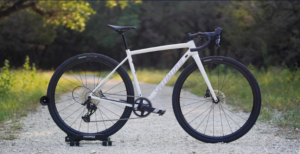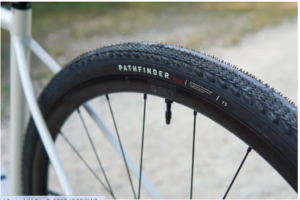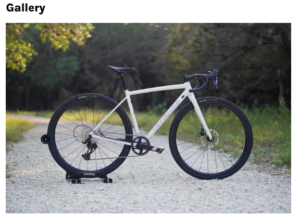
The formula for building an aluminum gravel bike is fairly straightforward. Build it to meet a price point, offer two paint schemes – one conservative and one that’ll pop on the sales floor – and print money. After all, an aluminum gravel bike is often one’s entry into cycling, not just gravel biking. So what’s up with this Specialized Crux DSW. which specialized postitions as a premium alloy gravel bike?
Specialized says its new Crux DSW gravel bike is the lightest aluminum gravel bike frame ever made. That’s a heady claim, but at 1,399 grams for a 56 cm frame, that weight means most traditional carbon gravel bikes are only about 1 pound lighter (-400 grams) than this.
Better still, the Crux DSW shares same geometry and tire clearances as the Crux gravel and cyclocross bike. That makes it a compelling option not only for folks who might not want carbon fiber, but for just about anyone looking at a gravel bike.
Below are build details, prices, comparisons to other gravel bikes, and my riding impressions aboard the Specialized Crux DSW. But I’ll spare you the details: aluminum bike fans are going to adore Specialized’s latest gravel bike.

Quick hits: Seven things to know about the Specialized Crux DSW
- Crux DSW is an aluminum version of the carbon Crux.
- A 56 cm frame is “lightest alloy gravel bike ever made.” at 1,399 grams.
- Max tire clearance: 700c x 47 mm or 650b x 53 mm.
- Features a SRAM Universal Derailleur Hanger (UDH).
- Geometry carries over from carbon Crux.
- Available in both frameset and complete bike options.
- For theusaak.com

The launch of the latest generation Specialized Crux carbon bike really stirred the pot amongst gravel bike fans out there. The Crux was lighter than just about any other gravel frame out there at 825 grams for a painted 56 cm frame. The S-Works model managed to be even 100 grams lighter than that, making for gravel bike that was lighter than many top-tier race road bikes.
Rather than carbon fiber, the Crux DSW uses Specialized’s familiar DSW aluminum frame construction, DSW-short for D’Aluisio Smartweld-essentially means the bike uses hydroformed aluminum tubes without old-fashioned mitering. The DSW process shaves weight by shaving all material that isn’t necessary while ensuring plenty of material at weld points.
The Crux DSW also uses a hydroformed one-piece downtube and bottom bracket area. This is relatively uncommon among alloy frames, as doing so adds considerable complexity and cost to the build process. In the case of the aluminum Crux, however, it allows Specialized to keep the weight down while having greater control of how the bike’s ride quality.
 Like the carbon Crux, there’s hardly anything proprietary going on. No internal cable routing at the handlebars, rather routing brake hoses and shift cables through the down tube and seat stays to accommodate both mechanical and electronic shifting. There’s a round 27.2 mm diameter seat post with a standard seat post clamp. A BSA-threaded bottom bracket complements the rest of the system.
Like the carbon Crux, there’s hardly anything proprietary going on. No internal cable routing at the handlebars, rather routing brake hoses and shift cables through the down tube and seat stays to accommodate both mechanical and electronic shifting. There’s a round 27.2 mm diameter seat post with a standard seat post clamp. A BSA-threaded bottom bracket complements the rest of the system.
This Crux DSW comes with a SRAM Universal Derailleur Hanger (UDH). allowing easier hanger replacement and compatibility with whatever 13-speed SRAM direct-mount derailleurs there might be.
Up front, the Crux DSW uses the same 12r carbon fork as the rest of the Crux lineup. There are three bottle cage mounts (two in the triangle and one just ahead of the bottom bracket). and not much else. It is a Crux, after all.
Geometry
| Size(all measurements in mm unless notes) | 49
Cm |
52
cm |
54
cm |
56
cm |
58
cm |
61
cm |
| Stack | 530 | 547 | 560 | 578 | 598 | 621 |
| Reach | 375 | 382 | 388 | 397 | 405 | 415 |
| wheelbase | 1008 | 1014 | 1023 | 1033 | 1045 | 1059 |
| Chainstay Length | 425 | 425 | 425 | 425 | 425 | 425 |
| Head Tube length | 100 | 115 | 130 | 147 | 167 | 190 |
| Head Tube angle | 70.5* | 71.25* | 71.5* | 72* | 72.25* | 72.5* |
| Fork Rake/Offset | 50 | 50 | 50 | 50 | 50 | 50 |
| Seat Tube Length | 466 | 496 | 521 | 546 | 576 | 606 |
| Fork Length, Full | 401 | 401 | 401 | 401 | 401 | 401 |
| Front center | 594 | 600 | 608 | 618 | 630 | 644 |
| Seat Tube Angle | 75.5* | 74* | 73.5* | 73.5* | 73.5* | 73.5* |
| BB Drop | 74 | 74 | 72 | 72 | 72 | 72 |
| Trail | 74 | 69 | 67 | 64 | 62 | 60 |
| Top Tube Length, Horizontal | 512 | 539 | 549 | 568 | 582 | 599 |
As mentioned, the Crux DSW shares its geometry with the rest of the Crux family. It isn’t a pure gravel bike. Rather, it kind of fits in the intersection of a gravel bike, a road bike, and a cyclocross bike. The 72 mm bottom bracket drop is high for a gravel bike but about standard for a cyclocross bike.
As far as fit is concerned, the Crux DSW isn’t a particularly upright bike. There’s more room to keep the bars up than the most racey gravel bikes out there, but fit geometry is still on the aggressive end of a gravel bike, and firmly in the ‘performance gravel’ side of things.
Builds, specs, and pricing
| Build | Specs | Price |
| Specialized Crux DSW Comp | SRAM Apex XPLR groupset | $2,600/E2,300/E2700/$4,000 AUD |
| Specialized Crux DSW frameset | N/A | $1,700/E1,500/E1,650/$2,500 AUD |
Specialized offers the Crux DSW in a frameset and just one complete build. The framesets are available in three colorways, while the complete SRAM Apex XPLR comes in two options. That bike gets a mechanical drivetrain, hydraulic shifting, and Specialized Pathfinder Pro tires. It’s nothing special, but the build checks all the boxes.
 Specialized sent over a 52 cm Crux DSW in its lone Apex XPLR build. Set up tubeless and without bottle cages, pedals, or any accessories, my bike weighed in at just 9.2 kg (20.2 pounds). That doesn’t sound all that lightweight, but that is just as light as a large percentage of entry-level carbon gravel bikes, and roughly 600 grams off of a Crux Comp with carbon fiber.
Specialized sent over a 52 cm Crux DSW in its lone Apex XPLR build. Set up tubeless and without bottle cages, pedals, or any accessories, my bike weighed in at just 9.2 kg (20.2 pounds). That doesn’t sound all that lightweight, but that is just as light as a large percentage of entry-level carbon gravel bikes, and roughly 600 grams off of a Crux Comp with carbon fiber.
For an aluminum bike with an aluminum seat post and handlebar. I found the Crux DSW to be comfortable… enough. The ride is firm, with a small amount of flex at the seat post. Considering the build, there isn’t much to complain about Those riding most of their time on gravel, however, will likely want to look into either wider tires, some sort of suspension seat post, or some carbon fiber there.
Truth be told, I quite liked how this bike handles. I think there’s a great balance to how it moves form gravel to singletrack to dirt to road and everywhere in between. It’s about spot on for someone who spent most of their time riding drop bar bikes and wants to hit some gravel. This is an attribute shared with the carbon version of the Crux, thankfully caring over seemingly unfiltered.

There’s a decent, if unremarkable, parts kit to be found here. SRAM’s Apex XPLR drivetrain with mechanical shifting might be the brand’s last holdout in drop bar drivetrains. but it doesn’t feel like an afterthought SRAM’s DoubleTap shift logic- using one paddle to control upshifts and downshifts-will likely require some time to get used to, but it is accurate and you can feel each shift Braking is easily controlled, and level ergonomics are and comfortable as well.
Similar praise can be heaped upon the touchpoints, neamely the handlebar, bar tape, and saddle, The Supacaz bar tape is grippy enough, and while it isn’t especially cushy, it has proven durable over the years. The bars offered multiple comfortable hand positions for gravel and blended in neatly with the aforementioned Apex shifters. No complainst about the Specialized Power saddle either

The DT Swiss G540 rims and Specialized hub are serviceable if unremarkable. The 38 mm Specialized pathfinder Pathfinder Pro tires set up tubeless with a floor pump, and the wheels didn’t seem to come out of true even after some nasty bottom-outs from the rim hitting the ground. They are on the heavy side, however; a quick wheel swap to a roughly 1,400 g Hunt 40 CGR wheelset saved 600 g (1.3 pounds).
Frankly, the Crux DSW benefits greatly from a lighter set of wheels, regardless of whether they’re aluminum or not The bike isn’t about being a weight weenie, but the difference is tangible in how much easier it is to maintain higher speeds after sapping. Were this my bike, the wheels would be the first thing I would to change.
The Crux DSW vs the competition
The Crux DSW functions both as a gravel bike and as a cyclocross bike, giving it an intriguing position in the market Amongst aluminum cyclocross bikes. there’s the Squid Squidcross… and not a whole lot else. But as cool as that bike is, the Squidcross is considerable more of a DIY situation.
That leaves aluminum gravel bikes for the Crux DSW to compete against, namely the canyon Grail AL, Cannondale Topstone, Giant Revolt, Specialized Diverge AL, and State 6061 All-Road among others. others. The Crux DSW is a decidedly more premium frame than those bikes, however, feeling more responsive and tight-feeling bike than those options with similar build kits. You pay for that privilege of having “the lightest gravel bike ever made,” however.
Perhaps the most intriguing competition comes from entry-level carbon gravel bikes. At $2600 US, a complete Crux DSW Comp is knocking on the door of that discounted, previous model year carbon fiber version of all of the aforementioned bikes. That makes the Crux DSW a tougher sell, and one I suspect most folks will go toward carbon fiber.
It’s also worth mentioning that against those carbon fiber bikes. the Crux DSW’s aluminum construction is inherently less energy-intensive than that of carbon fiber. Aluminum is also one of the most easily recyclable materials in the world. The same can’t be said for carbon fiber. That doesn’t make one material better than the other, but it is worth considering as you shop for a bike.








